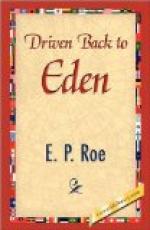From the first, my mind had often turned toward strawberries as one of our chief crops. They promised well for several reasons, the main one being that they would afford a light and useful form of labor for all the children. Even Bobsey could pick the fruit almost as well as any of us, for he had no long back to ache in getting down to it. The crop, also, could be gathered and sold before the raspberry season began, and this was an important fact. We should also have another and earlier source of income. I had read a great deal about the cultivation of the strawberry, and I had visited a Maizeville neighbor who grew them on a large scale, and had obtained his views. To make my knowledge more complete I wrote to my Washington-Market friend, Mr. Bogart, and his prompt letter in reply was encouraging.
“Don’t go into too many kinds,” he advised, “and don’t set too much ground. A few crates of fine berries will pay you better than bushels of small, soft, worthless trash. Steer clear of high-priced novelties and fancy sorts, and begin with only those known to pay well in your region. Try Wilson’s (they’re good to sell if not to eat) and Duchess for early, and Sharpless and Champion for late. Set the last two kinds out side by side, for the Champions won’t bear alone. A customer of mine runs on these four sorts. He gives them high culture, and gets big crops and big berries, which pay big. When you want crates, I can furnish them, and take my pay out of the sales of your fruit. Don’t spend much money for plants. Buy a few of each kind, and set ’em in moist ground and let ’em run. By winter you’ll have enough plants to cover your farm.”
I found that I could buy these standard varieties in the vicinity; and having made the lower part of the garden very rich, I procured, one cloudy day, two hundred plants of each kind and set them in rows, six feet apart, so that by a little watchfulness I could keep them separate. I obtained my whole stock for five dollars; therefore, counting our time and everything, the cost of entering on strawberry culture was slight. A rainy night followed, and every plant started vigorously.
In spite of occasional frosts and cold rains, the days grew longer and warmer. The cherry, peach, plum, and pear buds were almost ready to burst into bloom, but Mr. Jones shook his head over the orchard.
“This ain’t apple year,” he said. “Well, no matter. If you can make it go this season, you will be sure of better luck next year.”
He had come over to aid me in choosing a two-acre plot of ground for corn and potatoes. This we marked out from the upper and eastern slope of a large meadow. The grass was running out and growing weedy.
“It’s time it was turned over,” my neighbor remarked; “and by fall it’ll be in good condition for fruit.”
I proposed to extend my fruit area gradually, with good reason, fearing that much hired help would leave small profits.




